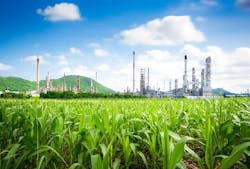Covenant Energy plans renewable diesel refinery in Saskatchewan
Covenant Energy Ltd. has let contracts to Haldor Topsoe AS and Gas Liquids Engineering Ltd. (GLE) as part of the operator’s plan to advance construction of Canada’s first standalone hydrogenation-derived renewable diesel (HDRD) and sustainable aviation fuel (SAF) refinery in southern Saskatchewan.
As technology provider for the project, Topsoe will license its proprietary HydroFlex technology to enable the proposed unit’s processing of 100% vegetable oil—including Canadian prairie-grown canola oil—into 6,500-b/d of premium renewable diesel that, given its lower carbon footprint vs. conventional diesel, will support Canada’s goal of carbon neutrality by 2050 under the country’s clean-energy diversification strategy, the service provider said on June 17.
Alongside HydroFlex, Topsoe confirmed it also will license its branded H2bridge technology that—based on modular Haldor Topsoe Convection Reformer (HTCR) technology—will equip the complex to produce renewable hydrogen from renewable LPG or naphtha instead of conventional fossil feedstocks.
The plant’s use of hydrogen resulting from the H2bridge technology in its processes will lower carbon intensity (CI) of fuels produced by the HydroFlex unit, as well as generate major compliance credits under Canada’s Clean Fuel Standard (CFS) by reducing greenhouse gas emissions (GHG) from the site by 80-85%, according to Topsoe and Covenant Energy.
In a separate release on June 16, Covenant Energy said it also has awarded a contract to GTE to provide unidentified engineering and project management (PM) services for the planned HDRD refinery.
Vancouver-based Turner International Group Ltd. will serve as corporate finance advisor to guide Covenant Energy through financing the development in line with the post-pandemic, green economy, the operator said.
While Covenant Energy previously targeted a startup date sometime in second-half 2023, the HDRD refinery is now scheduled enter operation in early 2024, according to Topsoe.
In a Mar. 18, 2021, release, the operator said the proposed HDRD refinery—which alongside producing renewable diesel and SAF also would produce arctic-grade renewable diesel—would create demand for a collocated crushing plant at the site equipped to crush 35 million bushels of canola seed to produce the refinery’s 325,000-350,000-tonnes/year canola oil feedstock requirement.
Based on the project’s already completed preliminary front-end engineering design and feedstock studies—as well as a completed marketing, demand, and pricing study—Covenant Energy said current design of the refinery additionally would enable the operator to invest in doubling the site’s production capacity at a later time.
Canada’s clean future
Covenant Energy said contract awards for the proposed renewables refinery development follows positive discussions with all levels of Canadian government, including federal regulators, regarding the country’s strengthened climate plan and programming first announced in late 2020 with the release of the CFS.
Published on Dec. 19, 2020, and taking effect on Dec. 1, 2022, the CFS will require liquid-fuel (gasoline, diesel, home heating oil) suppliers to gradually reduce the CI of the fuels they produce and sell for use in Canada over time, leading to a decrease of about 13% (below 2016 levels) in the CI of liquid fuels used in Canada by 2030.
To expedite transition to clean fuels, technologies, and processes across Canada, the federal government is developing a series of investments and initiatives complementary to the CFS aimed at incentivizing development of the country’s clean fuels sector, which includes a recent investment of $1.5 billion (Can.) towards a low-carbon, zero-emissions fuels fund to increase support for domestically produced low-carbon fuels and energy (e.g., biofuels, hydrogen) and their adoption.
Under the regulation, fuel suppliers will have flexibility to achieve compliance and generate credits, which can be created in three ways:
- Undertaking projects that reduce the lifecycle CI of fossil fuels (e.g., carbon capture and storage, renewable electricity).
- Supplying low-carbon fuels, such as ethanol in gasoline, or biodiesel in diesel.
- Supporting a switch to lower-carbon fuels or energy (electricity, hydrogen) to power vehicles from fossil-based fuels.
About the Author
Robert Brelsford
Downstream Editor
Robert Brelsford joined Oil & Gas Journal in October 2013 as downstream technology editor after 8 years as a crude oil price and news reporter on spot crude transactions at the US Gulf Coast, West Coast, Canadian, and Latin American markets. He holds a BA (2000) in English from Rice University and an MS (2003) in education and social policy from Northwestern University.

